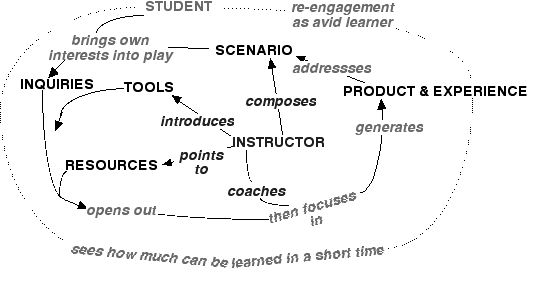Project- or Problem-Based Learning (PBL)
PBL involves the interaction of a set of elements, played out in relation to a number of tensions.
Elements
Scenario
(or case) raising problems (or issues) that often are not well defined, which invites
Students
(or participants) to bring their diverse interests, backgrounds, experiences, and capabilities into play as they formulate and pursue
Inquiries
which typically open out wide at first and evolve in unexpected directions, before the student focuses in to generate works in progress (or prototypes) on their way to a coherent
Product
(e.g., report) that is shared with other students and perhaps more widely, and from which other students learn. The inquiries are aided by the
Instructor-coach
who composes the scenario, coaches the students through the opening-out and focusing-in process, introduces Tools, points to Resources, elicits dialogue and reflection on the Experiences, and emphasizes learning interactions over grading.
Tools
and processes to help students organize inquiries or to foster support and engagement among the students.
 Elements of the PBL Process
Elements of the PBL ProcessResources
such as contacts, materials, and reading suggestions drawn from the instructor's own work and life and from previous students' projects. (The internet makes it easier to explore strands of inquiry beyond any well-packaged sequence of canonical readings, to make rapid connections with experts and other informants, and to develop evolving archives of materials and resources that can be built on by future classes and others).
Experiences
including, it is hoped, engagement in self-directed inquiry, seeing how much can be learned in a short time using the PBL structure (where learning is not only about the problems raised by the scenario but also about oneself as an inquirer), and moving through initial discomfort to re-engagement with oneself as an avid learner. What makes this re-engagement possible is a combination of the:
Tools and processes used for inquiry, dialogue, reflection, and collaboration
Connections made among the different participants who bring diverse interests, skills, knowledge, experience, and aspirations to the PBL
Contributions to the topic laid out in the scenario on which the PBL is based.
A student in a graduate PBL course evoked this experience:
This course is a gift—the chance to be open—open-ended in design, open to process, open to other perspectives, open to changing your ideas, and open to sharing. Of course this means it's risky too—you won’t always know when you’re coming from or where you are going—you might think you aren’t sufficiently grounded by the course. But you have the freedom to change that—and being on the other side of it now, I see it works out beautifully. The attention to process provides you the tools to grow and by the end you’re riding the wave of your earlier work…
Tensions
Scenarios—Content coverage?
How tightly is the steps and responsibilities scripted in the scenario so as to ensure that each student acquires knowledge, themes for interpretation and analysis, and skills pre-defined by the instructor versus aiming for content coverage by the class as a whole with products that include most of what the instructor could have dictated on their own but also go beyond that versus assuming that a well-written scenario will ensure that most of the problems defined and investigated by the students will relate to the subject being taught, while accepting gaps and some “curve balls” in return for student engagement in self-directed inquiry.
Scenarios—Real-world application?
Are the scenarios insulated from messy world or real world complexities versus learning and synthesizing that motivates further digestion and opens up directions for inquiry, yet happens within a “container” and is not tested by application and constituency-building in real world versus designing real-world action or change as well as build a constituency around them, thus stimulating ongoing Action Research Cycles and Epicycles.
Scenarios—Project vs. problem?
A wider range of issues may be raised in a medium- or long-term project, in which learning involves sustained thinking processes, behaviors, and planning and the focus of the inquiry takes time to move through works-in-progress or prototypes to get settled versus problem-finding and solving more locally in problem-based learning, with a focus more on the cognitive side of thinking and engaging with questions and framing problems in the moment. (In PBL, the connotations of “project” and “problem” are often not so distinct.)
Students/Experiences—Directedness?
How much consideration is given to students entering a PBL with a conventional sense of fulfilling explicit directions and being awarded a grade versus assuming that students finding their own feet—their self-directedness and re-engagement with themselves as avid learners—will overcome any initial disorientation—indeed will be a stronger experience for being able to look back on those initial reactions to PBL.
Students/Inquiries/Products—Group vs individual?
Do individuals or small groups generate the products? How much do students support each other? ...share and get feedback on their inquiries? ...on the final products?
Instructor-coaches—Responsibilities vs. responsiveness?
How much does the instructor monitor and assess students' progress and organize student-to-student exchange and support during the PBL unit versus wait and respond to what the student brings up for discussion and interaction?
Resources—Inverted pedagogy?
How much can PBL motivate students to identify and pursue the disciplinary learning and disciplined inquiry they need to achieve the competency and impact they desire versus customizing PBLs to match the command of fundamentals achieved before trying to tackle PBL scenarios.
Experience—Jostling?
How much does PBL highlight the need to be jostled by the interplay or tensions between the different considerations or tensions (or more generally those that are arise when making space for Taking Initiative In and Through Relationships versus programming a sequence of defined learning objectives.
(Taylor 2014 provides examples of a scenario, product, tool, and so on, as well as resources and references related to PBL.)
Taylor, P. J. (2014). “Examples.” http://www.cct.umb.edu/PBLguidedtour.html #examples (viewed 25 Oct 2018).